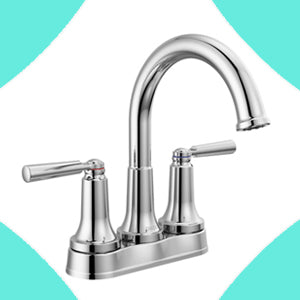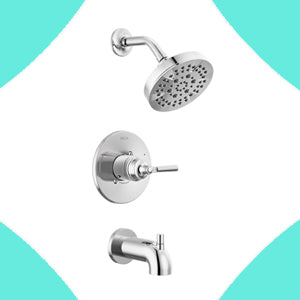How To Fix a Leaky Faucet: Your Guide
That persistent drip from your leaky faucet isn't just annoying, it's expensive. A single leaking faucet can waste up to three gallons of water a day, and for the sake of your water bill (and our planet), it’s time to fix that drip.
Plumbers can be an easy solution for leaky faucets, but they’re often quite expensive. In reality, fixing a faucet leak yourself isn’t as daunting as you might think. Leaky faucets are caused by a variety of issues, but most of them are relatively simple fixes. Here’s our DIY guide on how to fix a leaky faucet and save money and water.
Why Is My Faucet Dripping? Common Causes of a Leaky Faucet
Your faucet might be dripping for several reasons, and you’ll often find that the issue originates from a problem with your faucet’s seats, seals or cartridges.
-
Worn-out washers or o-rings: Washers and o-rings are small discs that help create watertight seals throughout the sink. They periodically wear out, crack or warp, causing the seals to break and triggering leaks. These items are very cheap and easy to replace.
-
Corroded valve seat: The valve seat is the surface on which washers sit. When you turn off the water, the washer presses against the seat to create the watertight seal. Over time—and especially in places with hard water—mineral and sediment buildup can corrode the seat, disrupting the seal.
-
Faulty cartridges: Your faucet cartridges help regulate the hot and cold water mix. Often, damaged seals and o-rings within the cartridges can trigger leaks.
-
Damaged ball assemblies: Some single-handle kitchen or bathroom faucets contain a ball bearing that controls both the water flow and temperature. The seal around the ball bearing is supposed to be tight. However, corrosion and damage can trigger leaks.
Your home’s water pressure might also cause a leaky faucet. If the water pressure is too high, it could strain the faucet’s internal components, damaging them and causing a leak.
What You’ll Need To Repair a Leaking Faucet
If you’re ready to fix a faucet leak by yourself, you’ll want to gather appropriate tools, including:
-
1/8-inch Allen wrench
-
Needle-nose pliers
-
Tongue-and-groove pliers
-
Screwdriver
-
A basin to catch any residual water
You will also want to gather appropriate replacement parts for your faucet. Consult your product specifications for the correct items.
Steps to Fix a Leaky Faucet
Please Note: This repair process applies to Delta kitchen faucets, bathroom faucets and tub/shower valves with a ball-valve assembly (seats and springs). It will not work on Delta Diamond SealⓇ Technology faucets.
1. Shut off both the hot and cold water supply valves under your sink. Turn on the faucet and let the last of the water trickle out. Drain the water lines completely.
2. Remove the faucet handle by taking off the screw cover. Use a screwdriver or Allen wrench to remove the screw. Lift off the handle. You should now see the faucet’s cap and adjusting ring. Depending on the age of your faucet, you may not have an adjusting ring. For those with newer faucets that don’t contain adjusting rings, please skip step three.
3. Investigate the cap and adjusting ring for corrosion, damage or looseness. Try tightening the adjusting ring with needle-nose pliers. If that doesn’t stop the leak, you’ll need to replace the faucet’s seats and springs.
4. To get to the seats and springs, unscrew and remove the adjusting ring (if your faucet has one). Then, unscrew the dome-shaped cap by placing a cloth over it for grip and using tongue-and-groove pliers to unscrew it. Be careful. If you use too much pressure to remove the cap, it may bend.
5. Pull out the round metal stem. When you do, you’ll remove the ball, as well as the piece called the cam and packing. Check for corrosion and damage. If your faucet’s leaking from here, replacing the cam and packing should resolve the problem.
6. Look into the valve and you’ll see a small mechanism called the seats and springs. The seat is the small circular part, and the spring is beneath the seat. Use the Allen wrench to pry out the seats and springs for both the hot and the cold water.
7. Remove the aerator and turn on both the hot and cold water all the way to flush the lines. Put a bucket upside down over the top of the faucet to direct the water down into the sink. Otherwise, water will spray everywhere. The water needs to run for one minute. Turn the water off at the supply lines again before reassembling the faucet.
8. Insert a new set of seats and springs into the holes. Thread one set onto the Allen wrench through the flat side of the seat, then through the skinny end of the spring. Use the wrench to tip the seat and spring into the hole in the valve. Repeat on the other set.
9. Replace the ball assembly, aligning the pin and the valve to the slot on the ball.
10. Replace the cam and packing, aligning the tab on the cam with the slot on the valve.
11. Gently screw the cap on the valve using only your hand. Replace the adjusting ring and tighten with needle-nose pliers. Reinstall the handle.
12. Turn on the water to ensure you’ve fixed the leak.
When To Upgrade or Replace Your Leaky Faucet
Although repairing your leaky sink faucet is relatively straightforward, it’s not a sure fix. If leaks persist after you tighten and replace any parts, or if your fixture is old or severely corroded, the damage might be too extensive. At this point, it’s time to think about installing a new sink faucet, which is something you can often handle without contacting a plumber.
Of course, when installing a new faucet, you’ll want to select one that has a low risk of leaking. The good news is that modern faucets are durable and designed to withstand years of use without corrosion or damage, lowering your risks of future leaks. You’ll want to choose one that fits your existing plumbing setup and complements your bathroom aesthetic.
For Reliable Faucets for Less, Shop Mintera
Mintera is home to the internet’s largest selection of mint-condition, recertified kitchen and bath faucets from leading brands like Delta, Kraus and Peerless. Shop products that are made to last and save up to 80% off the traditional retail price. It’s the best way to unlock savings while saving yourself from multiple faucet repairs in the future.




















